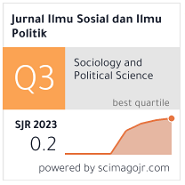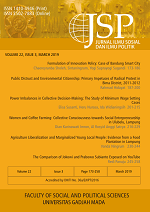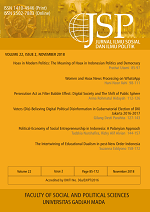The Association Between Conditional Cash Transfer and Fertility Intention in Indonesia
Rafly Parenta Bano(1*), Omas Bulan Samosir(2), Triasih Djutaharta(3)
(1) Statistic Merauke Regency, Indonesia
(2) The Faculty of Economics and Business, Universitas Indonesia, Indonesia
(3) The Faculty of Economics and Business, Universitas Indonesia, Indonesia
(*) Corresponding Author
Abstract
This study aims to analyze the relationship between conditional cash transfer (PKH in Indonesia)acceptance status and fertility intentions of married women ages 15-49 years who do not use contraception in Indonesia. The data used in this research comes from the results of SUSENAS 2017. The sample was limited to married women aged 15-49 years not currently using a contraceptive method. Ordinal logistic regression was employed to analyze the relationship between PKH acceptance status and fertility intention after controlling for the effects of individual control factors, while a multilevel ordinal logistic model was used to investigate the effects of contextual factors. The study results showed that after controlling for the effects of individual and contextual variables, a high fertility intention was associated with receiving PKH. Women from PKH beneficiary households tended to maximize the assistance received by increasing the number of children (moral hazard behavior ). Moral hazard behavior was more pronounced in women from households that had received PKH or received PKH but could not show their cards.
Keywords
Full Text:
PDFReferences
Adhikari, R. (2010). Demographic, Socio-Economic, and Cultural Factors Affecting Fertility Differentials In Nepal. BMC Pregnancy and Childbirth, 10, 1–11. https:// doi.org/10.1186/1471-2393-10-19
Ajzen, I., & Klobas, J. (2013). Fertility Intentions: An Approach Based on The Theory of Planned Behavior. Demographic Research,29(8), 203–232. https://doi.org/10.4054/demres.2013.29.8
Anjani, R., Hairunnisa, & Khoirunisa, A. R. (2019). Kampung Keluarga Berencana Sebagai Upaya Mengubah Paradigma Mitos Banyak Anak Banyak Rezeki. Seminar Nasional Bahasa Dan Sastra Indonesia Sasindo Unpam, 1(2), 141–146. Retrieved from ttps://jurnal.umj.ac.id/index.php/SAMASTA/article/view/7226/4454
Arceneaux, K., & Nickerson, D. W. (2009).Modeling Certainty with Clustered Data: A Comparison of Methods. Political Analysis, 17(2), 177–190. https://doi. org/10.1093/pan/mpp004
Arroyo, C. R., & Zhang, J. (1997). Dynamic microeconomic models of fertility choice: A survey. Journal of Population Economics, 10(1), 23–65. https://doi.org/10.1007/s001480050030
Badan Pusat Statistik. (2018). Indonesia-Survei Sosial Ekonomi Nasional 2017 Maret (KOR). Jakarta.
Bastanta, Z. (2017). Evaluasi Dampak Program Bantuan Tunai Bersyarat Terhadap Fertilitas : Kas us Pro gram Keluarga Harapan (PKH) di Indonesia. Universitas Indonesia.
Bourguignon, F., Ferreira, F. H. G., & Leite, P. G. (2003). Conditional Cash Transfers, Schooling, and Child Labor: Micro- Simulating Brazil’s Bolsa Escola Program. World Bank Economic Review, 17(2), 229–254. https://doi.org/10.1093/wber/lhg018
Chauvet, G. (2015). Coupling methods for multistage sampling. Annals of Statistics, 43(6), 2484–2506. https://doi. org/10.1214/15-AOS1348
Cheng, Y. hsin A., & Hsu, C. H. (2020). No More Babies without Help for Whom? Education, Division of Labor, and Fertility Intentions. Journal of Marriage and Family, 82(4), 1270–1285. https://doi.org/10.1111/jomf.12672
Dewey, K. G., & Begum, K. (2011). Long-Term Consequences of Stunting in Early Life. Maternal and Child Nutrition, 7(SUPPL.3), 5–18. https://doi.org/10.1111/j.1740-8709.2011.00349.x
Ewemooje, O. S., Biney, E., & Amoateng, A. Y. (2020). Determinants of Fertility Intentions Among Women of Reproductive Age in South Africa: Evidence From The 2016 Demographic and Health Survey. Journal of Population Research. https://doi. org/10.1007/s12546-020-09246-w
Fahmi, S., & Pinem, M. (2018). Analisis Nilai Anak dalam Gerakan Keluarga Berencana bagi Keluarga Melayu. Jupiis: Jurnal Pendidikan Ilmu-Ilmu Sosial, 10(1), 112. https://doi.org/10.24114/jupiis.v10i1.9653
Fiszbein, A., Schady, N., Ferreira, F. H. G., Grosh, M., Keleher, N., Olinto, P., & Skoufias, E. (2009). Conditional Cash Transfers. In Conditional Cash Transfers. https://doi.org/10.1596/978-0-8213-7352-1
Garganta, S., Gasparini, L., Marchionni, M., & Tappatá, M. (2017). The Effect of Cash Transfers on Fertility: Evidence from Argentina. Population Research and Policy Review, 36(1), 1–24. https://doi. org/10.1007/s11113-016-9417-x
Gulematova, M. (2011). Evaluating The Impact of Conditional Cash Transfer Programs on Adolescent Decisions About Marriage and Fertility: The Case of Oportunidades (Vol. 25). https://doi.org/10.1007/s00148-010-0337-5
Gustafsson, S. (2001). Optimal Age at Motherhood. Theoretical and Empirical Considerations on Postponement of Maternity in Europe. Journal of Population Economics, 14(2), 225–247. https://doi. org/10.1007/s001480000051
Handa, S., Halpern, C. T., Pettifor, A., & Thirumurthy, H. (2014). The Government of Kenya’s Cash Transfer Program Reduces The Risk of Sexual Debut Among Young People Age 15-25. PLoS ONE, 9(1). https:// doi.org/10.1371/journal.pone.0085473
Handa, S., Peterman, A., Huang, C., Halpern, C., Pettifor, A., & Thirumurthy, H. (2015). Impact of The Kenya Cash Transfer For Orphans and Vulnerable Children on Early Pregnancy and Marriage of Adolescent Girls. Soc Sci Med., 141, 36–45. https://doi.org/doi:10.1016/j.socscimed.2015.07.024
Heck, R. H., Thomas, S. L., & Tabata, L. N. (2010). Multilevel and Longitudinal Modeling With IBM SPSS. New York, NY: Routledge.
Heiland, F., Prskawetz, A., & Sanderson, W. C. (2008). Are Individual’s Desired Family Sizes Stable? Evidence From West German Panel Data. European Journal of Population, 24(2), 129–156. https://doi. org/10.1007/s10680-008-9162-x
Hosmer, D. W., & Lemeshow, S. (2000). Applied Logistic Regression Second Edition. In Applied Logistic Regression. https://doi. org/10.1002/0471722146
Hox, J. J. (2010). Multilevel Analysis. Techniques and Applications (Second Edi). https:// doi.org/10.4028/www.scientific.net/ AMM.556-562.5968
Huang, F. L. (2016). Alternatives to Multilevel Modeling for the Analysis of Clustered Data. Journal of Experimental Education, 84(1), 175–196. https://doi.org/10.1080/00220973.2014.952397
Kemensos. (2019). Pedoman Pelaksanaan PKH Tahun 2019. Jakarta: Kementerian Sosial Republik Indonesia.
Kementerian Sosial. Peraturan Menteri Sosial Nomor 1 2018 Tentang Program Keluarga Harapan. , Pub. L. No. 1 Tahun 2018 (2018).
Leroy, J. L., Ruel, M., Habicht, J. P., & Frongillo, E. A. (2014). Linear Growth Deficit Continues To Accumulate Beyond The First 1000 Days in Low and Middle-Income Countries: Global Evidence From 51 National Surveys. Journal of Nutrition, 144(9), 1460–1466. https://doi.org/10.3945/jn.114.191981
Malthus, T. (1798). An Essay on the Principle of Population. London: St. Paul’s Church- Yard.
Marquart-Pyatt, S. T. (2012). Contextual Influences on Environmental Concerns Cross-Nationally: A M ultilev el Investigation. Social Science Research, 41(5), 1085–1099. https://doi.org/10.1016/j.ssresearch.2012.04.003
McGuire, C., & Stephenson, R. (2015). Community Factors Influencing Birth Spacing among Married Women in Uganda and Zimbabwe. African Journal of Reproductive Health, 19(1), 14–24.
Mills, M., Mencarini, L., Tanturri, M. L., & Begall, K. (2008). Gender Equity and Fertility I ntentio ns in I taly and the Netherlands. Demographic Research, 18. https://doi.org/10.4054/demres.2008.18.1
Musca, S. C., Kamiejski, R., Nugier, A., Méot, A., Er-Rafiy, A., & Brauer, M. (2011). Data with Hierarchical Structure: Impact of Intraclass Correlation and Sample Size on Type-I Error. Frontiers in Psychology, 2(APR), 1–6. https://doi.org/10.3389/fpsyg.2011.00074
Nandi, A., & Laxminarayan, R. (2016). The Unintended Effects of Cash Transfers on Fertility: Evidence from the Safe Motherhood Scheme in India. Journal of Population Economics, 29(2), 457–491. https://doi.org/10.1007/s00148-015-0576-6
Phan, L. (2013). Women’s Empowerment and Fertility Changes. International Journal of Sociology of the Family, 39(1), 49–75.
Rosenberg, M., Pettifor, A., Nguyen, N., Westreich, D., Bor, J., Bärnighausen, T., Kahn, K. (2015). Relationship between Receipt of a Social Protection Grant for a Child and Second Pregnancy Rates among South African Women: A Cohort Study. PLoS ONE, 10(9), 1–12. https://doi. org/10.1371/journal.pone.0137352
Snijders, T., & Bosker, R. (1999). Multilevel Analysis: An Introduction to Basic and Advanced Multilevel Modeling. London: SAGE Publications.
Stecklov, G., Winters, P., Todd, J., & Regalia, F. (2007). Unintended Effects of Poverty Programmes on Childbearing in Less Developed Countries: Experimental Evidence from Latin America. Population Studies, 61(2), 125–140. https://doi.org/10.1080/00324720701300396
Testa, M. R. (2014). On The Positive Correlation betw een E ducation and Fertility Intentions in Europe: Individual- And Country-Level Evidence. Advances in Life Course Research, 21, 28–42. https://doi. org/10.1016/j.alcr.2014.01.005
Todd, J. E., Winters, P., & Stecklov, G. (2012). Evaluating the Impact of Conditional Cash Transfer Programs on Fertility: The Case of the Red De Protección Social in Nicaragua. Journal of Population Economics, 25(1), 267–290. https://doi.org/10.1007/s00148-010-0337-5
Utomo, D., Hakim, A., & Ribawanto, H. (2014). Pelaksanaan Program Keluarga Harapan Dalam Meningkatkan Kualitas Hidup Rumah Tangga Miskin (Studi pada Unit Pelaksana Program Keluarga Harapan Kecamatan Purwosari, Kabupaten Kediri). Jurnal Administrasi Publik, 2(1),29–34.
Whittemore, A. S. (1997). Multistage sampling designs and estimating equations. Journal of the Royal Statistical Society. Series B: Statistical Methodology, 59(3), 589–602. https://doi.org/10.1111/1467-9868.00084
Article Metrics
Refbacks
- There are currently no refbacks.
Copyright (c) 2022 Jurnal Ilmu Sosial dan Ilmu Politik

This work is licensed under a Creative Commons Attribution-NonCommercial-NoDerivatives 4.0 International License.






















